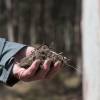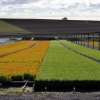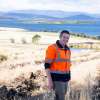
Expert Q&A series: Hear from Climate Friendly's Zoe Ryan
Posted 23 June 2021
Managing trees On-farm benefits Economic benefits and markets Carbon benefits Native regrowth forest management PFT
Private landowners in Tasmania have expressed a strong interest in using trees to reduce climate impacts by sequestering more carbon.
Coincidentally, this carbon investment will increase the economic return from trees on farms which adds to a myriad of other benefits.
Climate Friendly is one of Australia’s largest, most experienced carbon farming project developers. Climate Friendly is not only helping share the carbon benefits of planting trees, they’re also playing a critical role in getting trees in the ground - right here in Tasmania.
Climate Friendly is in the business of reducing emissions, and their activities are focused on achieving large scale impacts while delivering economic, social and environmental benefits. Their vision is for a productive, sustainable land sector that contributes to a zero net emission Australia by 2050. They have already achieved 20 million tonnes of greenhouse gas reductions at the end of 2020, and their purpose is to scale up to 100 million tonnes by 2025.
Climate Friendly is hitting these goals by supporting rural, regional and remote Australians including farmers, foresters and traditional custodians to reduce Australia’s greenhouse gas emissions and regenerate the landscape through carbon farming.
We caught up with Zoe Ryan, Executive Manager of Business Development at Climate Friendly to discuss the benefits of planting trees for farmers, their future and for the betterment of our environment.
- Name and area of expertise
Zoe Ryan, Executive Manager of Business Development at Climate Friendly. - Why should Tasmania’s farmers and landowners consider planting trees with the intention of harvesting and replanting?
There are so many reasons but the top three would be 1. It helps to reduce the emissions from the atmosphere and if we harvest and replant trees, there’s an ongoing cycle of carbon being stored in wood products. 2. Wood is one of the most sustainable building products. Having worked internationally, Australia has world leading environmental standards in wood production. It’s also better to grow here as opposed to other countries as it minimises the miles it takes for products to travel. 3. When trees are planted in a shelterbelt configuration, it provides incredible shelter for livestock. You only have to see the behavior of livestock on a hot day to see the benefits and evidence also shows that shelterbelts in paddocks create more productivity because of reduced evaporation.
- Is there a common misconception from farmers and land owners around planting trees you want to debunk?
Often times farmers think that if they plant trees for saw log or pulp, they’ll be able to find a market for their trees. But end harvest market must be considered from the start, even before planting. Farmers and landowners need to think of the end use, how the trees will be harvested and how they will get to a mill or a port, or whether they are willing to do the harvest and processing themselves using a portable mill.
There’s also the idea that carbon is lost from trees when they are harvested. This is simply untrue. Carbon is stored in wood even after harvest - and often for a very long time.
- What makes Tasmania well positioned to be industry leaders in farm forestry?
Tasmania has excellent growing conditions and also has a clean green image. Trees are already a part of the landscape. There’s also a very well-established forest industry in Tasmania and good industry support from bodies like Tree Alliance.
- Is there a single recommendation or piece of advice you would offer farmers or landowners who are on the fence about planting trees?
If you’re entering into a carbon project, the scale of the planting matters. If it’s too small, farmers won’t be able to cover the transaction costs of participating. We’re working really hard to address this issue for small scale participants through an aggregated carbon project in Tasmania, and also through advocacy with Government. Keep checking in for more updates.
- Have you seen a change in the farm forestry industry in the last decade?
I’ve noticed a new level of interest in farm forestry from the increasing number of farmers who are transitioning to regenerative agriculture. It used to be the only people interested were farmers specifically interested in agroforestry but now its agriculture based farmers interested in maximizing productivity of livestock and introducing trees as means of achieving carbon neutrality.
- Is there a first-hand account that comes to mind where you’ve seen a farmer or landowner reap the benefits of having planted trees?
Yes! Twenty years ago, on my own family’s farm in North East Victoria, I helped my father plant a shelterbelt on our 70 acre paddock. Those trees have now matured, and the sheep are under the shelter of those trees every single day. It’s where they spend most of their time. It’s nice to see animals and not just humans, taking advantage of these trees. Not only do they enjoy the trees but they’re there for a reason - for increased survival for their lambs, and to reduce their own exposure to sun and wind.
- If someone is interested in planting trees on their farm/land, what’s something that should be considered that’s often overlooked?
Aside from the location and end use of trees, carbon! People should at least look into a carbon credit system. Carbon can help offset most if not all establishment costs if they have the right size of farm/land, so they should really consider factoring carbon into their business model. Forest carbon projects also work well alongside other carbon projects such as soil carbon sequestration, so they might like to consider more than one carbon project on their farm.
- What role do you see trees playing in helping protect land for future generations?
Trees not only help climate mitigation but they’re helping landowners with climate adaptation, and also diversifying their income.
- How important is it to plant the right trees in the right place?
We need to increasingly think about this a lot in terms of climate change. What will the climate be in the future and what can be planted for that future climate are topics that should be taken into consideration moving forward.
- How can Climate Friendly be of assistance to those interested in planting/harvesting trees?
Climate Friendly is running small scale plantation forestry carbon project aggregation in Tasmania, and we’re always interested in hearing from landowners interested in participating in this project! Get in touch via the website - we’d love to hear from you.
Zoe heads up the Business Development Unit at Climate Friendly. She grew up on a farm in North Eastern Victoria, and is passionate about climate change, forests, and sustainable agriculture. Her career in forestry has spanned government, private sector and consultancies, and included working with non-government organisations on international REDD+ projects. Zoe holds a Bachelor Forest Science (Hons); Masters Science (Forestry); Postgraduate Certificate in Bush fire Planning and Management.





